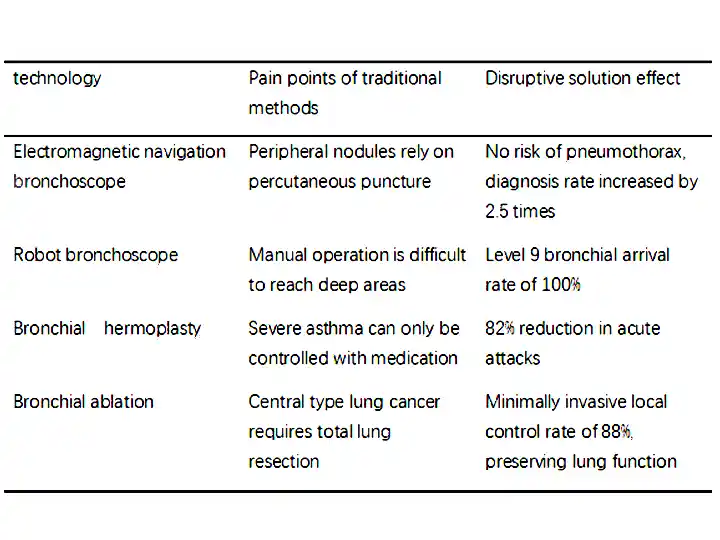Table of Contents
1、 Revolutionary breakthrough in diagnostic technology
1. Electromagnetic Navigation Bronchoscopy (ENB)
Disruptive: Addressing the diagnostic challenge of peripheral pulmonary nodules (≤ 2cm), the biopsy positivity rate has increased from 30% in traditional bronchoscopy to over 80%.
Core Technology:
CT three-dimensional reconstruction+electromagnetic positioning: such as Veran Medical's SPiN Thoracic Navigation System, which can track the position of instruments in real time (with an error of less than 1mm).
Respiratory motion compensation: SuperDimension ™ The system eliminates the impact of respiratory displacement through 4D positioning.
Clinical data:
The diagnostic accuracy for 8-10mm pulmonary nodules is 85% (Chester 2023 study).
Combined rapid on-site cytological assessment (ROSE) can reduce operation time by 40%.
2. Robot assisted bronchoscopy
Representative system:
Monarch Platform (Auris Health): The flexible robotic arm achieves 360 ° steering to reach the 8th to 9th level bronchi.
Ion (Intuitive): 2.9mm ultra-fine catheter+shape sensing technology, with a puncture accuracy of 1.5mm.
Advantages:
The success rate of obtaining nodules from the upper lobe of the lung has been increased to 92% (compared to only 50% with traditional microscopy).
Reduce complications such as pneumothorax (incidence rate<2%).
3. Confocal Laser Endoscopy (pCLE)
Technical highlight: Cellvizio ® The 100 μ m probe can display alveolar structure in real-time (resolution of 3.5 μ m).
Application scenarios:
Immediate differentiation between in situ lung cancer and atypical adenomatous hyperplasia (AAH).
In vivo pathological evaluation of interstitial lung disease (ILD) to reduce the need for surgical lung biopsy.
2、 Disruptive solutions in the field of treatment
1. Endoscopic lung cancer ablation
Microwave ablation (MWA):
Guided by electromagnetic navigation, bronchial ablation achieved a local control rate of 88% (≤ 3cm tumor, JTO 2022)。
Compared to radiotherapy: there is no risk of radiation pneumonitis and it is more suitable for central lung cancer.
Cryoablation:
The Rejuvenair system from CSA Medical in the United States is used for frozen recanalization of central airway obstruction.
2. Bronchoplasty (BT)
Disruptive: Device therapy for refractory asthma, targeting smooth muscle ablation.
Alair system (Boston Scientific):
Three surgeries reduced acute asthma attacks by 82% (AIR3 Trial).
The 2023 updated guidelines are recommended for GINA grade 5 patients.
3. Airway stent revolution
3D printing personalized bracket:
Based on CT data customization, solve complex airway stenosis (such as post tuberculosis stenosis).
Material breakthrough: Biodegradable magnesium alloy stent (experimental stage, fully absorbed within 6 months).
Drug eluting stent:
Paclitaxel coated stents inhibit tumor regrowth (reducing restenosis rate by 60%).
3、 Application in critical and emergency situations
1. ECMO combined with bronchoscopy
Technological breakthrough:
Supported by portable ECMO (such as Cardiohelp system), bronchoalveolar lavage (BAL) is performed for ARDS patients.
Verification of operational safety for patients with oxygenation index<100mmHg (ICM 2023).
Clinical value: Clarify the pathogen of severe pneumonia and adjust the antibiotic regimen.
2. Emergency intervention for massive hemoptysis
New hemostatic technology:
Argon plasma coagulation (APC): non-contact hemostasis with controllable depth (1-3mm).
Freezing probe hemostasis: -40 ℃ low-temperature closure of bleeding vessels, recurrence rate<10%.
4、 Frontier exploration direction
1. Molecular imaging endoscopy:
Fluorescent labeling of PD-L1 antibodies (such as IMB-134) to display the real-time immune microenvironment of lung cancer.
2. AI real-time navigation:
The Johnson&Johnson C-SATS system automatically plans the optimal bronchial path, reducing operation time by 30%.
3. Micro robot cluster:
MIT's magnetic microrobots can carry drugs to alveolar targets for release.
Clinical Effect Comparison Table

Implementation path suggestions
Primary hospitals: equipped with ultrasound bronchoscopy (EBUS) for mediastinal staging.
Third class hospital: Establish ENB+robot intervention center to carry out integrated diagnosis and treatment of lung cancer.
Research institution: Focusing on molecular imaging and biodegradable scaffold development.
These technologies are reshaping the clinical practice of respiratory intervention through three major breakthroughs: precise delivery, intelligent diagnosis, and ultra minimally invasive treatment. In the next 5 years, with the development of AI and nanotechnology, the diagnosis and treatment of pulmonary nodules may achieve "non-invasive closed-loop management".
Copyright © 2025.Geekvalue All rights reserved.Technical Support:TiaoQingCMS